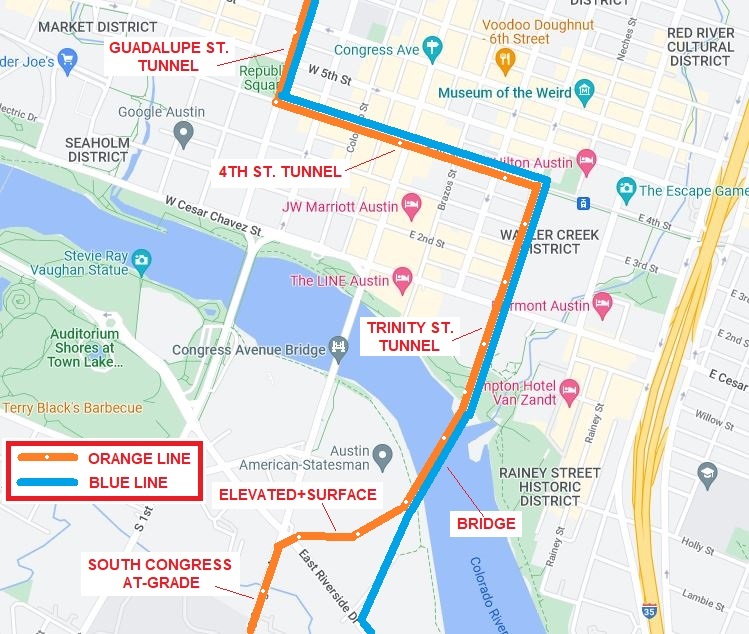
By Lyndon Henry
Lyndon Henry, an urban and transportation planner, is a technical consultant to the Light Rail Now Project of Texas Association for Public Transportation (a Texas nonprofit organization) and contributing editor to Austin Rail Now (ARN). He is also a member of the Engineering, Architecture and Construction (EAC) Advisory Committee of the Austin Transit Partnership (ATP), the public agency overseeing Austin’s major transit development program (including light rail) approved by city voters in November 2020.
In April 2022, Project Connect reported it was encountering a $4.5 billion budget overrun in its light rail transit (LRT) program, of which $3.9 billion was linked to the Orange Line and tunnel segments. In a May2022 memo to the EAC committee, Lyndon noted that much of this “appears to be a result of the extension of the subway tunnel under the river, the South Bank, and South Congress Avenue” (which had replaced an earlier conception of a surface alignment and bridge). As remedial measures, Lyndon offered proposals to consolidate the Orange and Blue lines into a single tunnel alignment through downtown and onto a single crossing, by bridge, over the Colorado River (Lady Bird Lake). These ideas are being considered by the Project Connect team as possible design alternatives.
In an effort to contribute to the “criteria evaluation and project optimization” goals of a 22 October Light Rail Workshop of several ATP advisory groups, including the EAC, Lyndon submitted a handout proposing his tunnel and bridge consolidation plan plus suggesting a redesign of the South Congress light rail extension as a surface alignment, “avoiding the heavy cost of a subway tunnel in this segment.” These ideas “appear to offer potential to reduce cost and speed up construction, helping to fulfill what voters have approved” he noted, adding that “Hopefully, at least a portion of the proposed extension into Central South Austin might be completed per the original schedule.” The below presents the proposals in that workshop handout.
With serious potential budget overruns posed by the transit system plan designs to date, the Project Connect team has been seeking ideas for alterations and alternatives. Here are some of my own thoughts and proposals toward “criteria evaluation and project optimization” as requested in this workshop.
Securing public trust
A major premise of my approach, based on 50 years of involvement and research in public transportation, is that maintaining public trust is absolutely crucial to a project of this importance and magnitude.
Public expectations should be highly valued. Accordingly, my proposals are intended to maintain as much of the original light rail transit (LRT) route structure and completion schedule as possible, remaining faithful to what voters have approved. Given the budget problems and constraints that have emerged, this seems to imply some major changes to plan configurations, particularly infrastructure design, to reduce budgetary investment cost and minimize construction time.
Downtown subway reconfiguration
In the map [shown above] (originally presented to the EAC Advisory Committee in May), I have proposed an alternative alignment for the Orange Line southward from Republic Square, eliminating the currently proposed tunnel under the river to the South Bank and into South Congress Avenue. Instead, from Republic Square southward the Orange Line would follow the Blue Line alignment via the 4th St. tunnel, then the Trinity tunnel. Emerging just north of the Colorado River, the Orange Line would then share the proposed bridge over to the South Bank.
On the South Bank, the Orange Line would branch westward via available real estate and Riverside Drive right-of-way over to South Congress Avenue (a station could be installed in this area to provide approximately 0.4-mile access to Auditorium Shores and the Long Center). Sharing the Blue Line alignment via 4th St./Trinity St. and the proposed transit bridge as an alternative connection from downtown to the South Bank would alone reduce investment cost significantly (perhaps by $1 billion or more). The Orange Line could then proceed into the South Congress corridor either in tunnel or as a surface alignment.
South Congress surface alignment
A surface alignment on South Congress Avenue (as proposed in the original conception of this LRT project) in lieu of tunnelling would offer another means of substantial construction cost and time saving and likely facilitate at least some of the previously proposed extension of the Orange Line into Central South Austin by 2029. Perhaps the widest local arterial in the central city, South Congress offers a virtually ideal opportunity for surface light rail. (See graphic simulation, below.)
Construction of surface facilities (e.g., stations, overhead contact system) should be possible within the Capitol View Corridors (CVC) regulatory guidelines at least as far south as Mary Street. (As defined by the Downtown Commission in a 2007 document, “A view corridor is a plane that extends from a defined view point or points to the base of the Capitol dome. … No structure is permitted to pierce the plane.”) To avoid obstructing the CVC in the remaining short segment from Mary to south of Live Oak St., trains could operate on batteries or perhaps a technology such as Alstom’s proprietary APS (alimentation par sol – ground power) electrification system, which uses a surface power strip between the rails which is electrified only when a train is passing on that section of track.

Rethinking intersection with Cesar Chavez St.
So far, design of LRT alignments downtown has been constrained by the assumption that Cesar Chavez St. with its heavy traffic flow cannot tolerate the interruptions from a surface intersection with light rail. However, LRT lines in various other cities have worked well for decades with surface intersections with similar major arterials (e.g., Portland’s original MAX LRT line has crossed the city’s major 5th and 6th Avenues downtown since 1986). Elimination of this constraint, thus permitting LRT surface crossings of Cesar Chavez, could provide Project Connect greater planning flexibility and lead to even more substantial cost savings. ■

